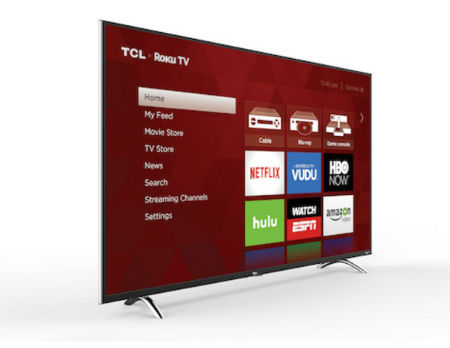Bloom: Roku Goes Big For Small Fry with Shopify Ad-Tech Deal
Roku is launching a new app to help Shopify vendors buy and build targeted video advertising campaigns for their products on Roku video channels. Your retinas may bleed as a result, but it will be nothing if not fascinating to watch

The ability to buy “Jennifer Aniston’s sweater” has been a near-mythical quest for TV companies for a couple of decades, as the experience of watching “TV” has increasingly gone online, interactive and commerce-friendly. Now, Roku wants to equip mom-and-pop sellers on Shopify with the video sales tools they need to hock all kinds of sweaters, tchotchkes, foodstuffs and other odds and ends with build-your-own ad campaigns across all of Roku’s channels.
Oh, boy.

If small and medium-sized businesses can actually leverage the tools, it could be a far more consequential move than acquiring that library of Quibi leftovers for “Roku Originals.” The new tech tools could germinate a relatively untapped crop of video advertisers even as Roku’s ambitions, and the list of its increasingly competent and huge competitors, grow.
Under the deal, Roku is launching a new app specifically to help Shopify vendors buy and build targeted video advertising campaigns for their products on Roku video channels.
The deal makes sense on multiple levels, including the most essential: Shopify, like Roku, must compete directly with e-commerce and TV titan Amazon. As the old saying goes, the enemy of my enemy is my new business partner.
By joining forces, the two smaller companies may slightly level their respective playing fields, while also unleashing a bewildering Burgess Shale moment of little-guy advertising creativity. My retinas may bleed as a result, but it will be nothing if not fascinating to watch.
The Roku app will be distributed through Shopify’s App Store, where merchants can “choose their campaign budget, timing, and duration and upload creative. Within minutes, they’ll be able to launch their campaign and deliver their brand and message directly” to Roku’s 55 million active users, according to Roku’s upbeat announcement.
NEXT TV NEWSLETTER
The smarter way to stay on top of the streaming and OTT industry. Sign up below.
The Roku tool, one of 7,000 on Shopify’s App Store, means "merchants can bring their products directly to TV screens, while allowing consumers to discover exciting new brands right from their living room,” a Shopify executive threatened in the release.
Indeed, the biggest obstacle to success may be that advertisers still need to create their own commercials before uploading them for Roku distribution. Apps to simplify that process most likely are on the way, too.
Roku claims the app will mark “a significant advancement from traditional linear and cable TV advertising solutions, which offer limited targeting and measurement options.” The ads will help at every stop along “the sales funnel,” as marketing types like to call it, not just in the “Now You’ve Heard of Us” mode of classic brand awareness campaigns.
That may well be the case. With the app set to launch ahead of this holiday season, I for one look forward to being carpet-bombed by companies I’ve never heard of, using the video equivalent of weird flashing fonts we used to see on desktop publishing fliers in the early 1990s, GeoCities sites in the late 1990s, MySpace pages in the early 2000s, and car-dealership ads on cable since forever. From this noble lineage shall these new Roku-Spotify vendor ads spring. Pray for us all.
I can’t help worrying, though, about some of the practical effects of that small-business graphic sensibility, especially when bound to the power of video, tied to highly susceptible targeted audiences, and splashed across the video cosmos.
Will the American populace suffer from blindness, convulsions and emesis from exposure to these holiday gift-giving ads, at least until more delicate and tasteful graphic sensibilities seize back control? If so, it would be yet another reprise of a cycle that also dates back to the taming of the desktop publishing revolution.
Or perhaps I worry too much about collateral damage. The real effect here is bringing to Roku audiences the power of Facebook and Instagram targeted interactive ads. As too many of you know, those ads are distressingly effective at extracting dollars from your wallet to acquire things you never knew existed, much less that you “needed.”
Some of the initial vendors given access to the terrible power of these tools include Birthdate Co, Jambys, Moon Pod, and OLIPOP, a true murderer’s row of “what’s that?” Potential additional vendor candidates are urged to apply directly to a Shopify page on Roku’s advertising site.
A Jamby’s executive quoted in the announcement declared his company’s initial results were extremely promising, boosting “consideration” by a whopping 63% for Jamby’s “performance inactivewear” (I literally couldn’t make this stuff up, but I suppose it sounded better than “non-performance activewear” as a marketing description).
Best of all, you can create a performance ad about your performance inactivewear without leaving the couch, if you’re creative enough (because where else would you wear performance inactivewear?). Soon, we’ll see activated audiences buying cowboy vest loungewear right from that long-tail Roku channel of black-and-white TV Westerns.
The new ad tools also make for an interesting riposte to Amazon’s persistent efforts to build a live streaming e-commerce presence. It’s a bid to capture something like the tens of billions of dollars generated in China by live-streamed influencers there selling pretty much everything you can imagine.
Some of the Chinese live-streamed sales humans have become huge media stars as the sector has proven ludicrously lucrative in China. Or at least it was ludicrously lucrative before the Chinese government began outlawing tech giants, tech giant billionaire owners, billionaire actress/spokesmodels, video game giants, video game playing, cryptocurrency miners, cryptocurrency users, after-school tutors, technically bankrupt real-estate companies, religious and ethnic groups, exercise groups, and other potential threats to the republic’s “common prosperity.” Now, who knows what’s going to be okay?
Amazon is no Xi Jinping, but is nearly as ambitious about attaching e-commerce to at least some of its countless video initiatives.
It seems clear we’ll soon see an Amazonian response to the Roku-Shopify approach, only for Fire TVs, sticks, pucks, tablets, smart speakers, and dongles. And you can bet Alphabet will be close behind as it further hones its Google TV/Android TV two-headed TV beast. Will the TV makers such as Vizio, TCL, LG, Samsung and Sony (not to mention those new Comcast-branded sets) join in as part of their built-in platforms?
Seems possible, sooner or later. I for one am off to buy new sunglasses (online of course) to reduce the glare from all the flashing fonts headed my way, again.
David Bloom of Words & Deeds Media is a Santa Monica, Calif.-based writer, podcaster, and consultant focused on the transformative collision of technology, media and entertainment. Bloom is a senior contributor to numerous publications, and producer/host of the Bloom in Tech podcast. He has taught digital media at USC School of Cinematic Arts, and guest lectures regularly at numerous other universities. Bloom formerly worked for Variety, Deadline, Red Herring, and the Los Angeles Daily News, among other publications; was VP of corporate communications at MGM; and was associate dean and chief communications officer at the USC Marshall School of Business. Bloom graduated with honors from the University of Missouri School of Journalism.
